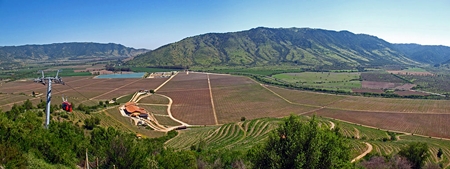One of the great non-truths of our age is that wine improves with time. Some people have the fanciful idea that if they keep a bottle of wine long enough, mysterious forces will get to work and transform it from ordinary plonk into nectar for the gods. Sadly, this simply isn’t true. If it were, I’d have made a fortune long ago. It’s been estimated that 99% of the world’s wines should be consumed as soon as possible after purchase. Normally, white wines should used within a year or two, while reds can last a little longer but rarely more than three years. And don’t forget that unless you keep your wines in some kind of temperature-controlled environment, our tropical climate will probably finish them off before you do.
We need hardly concern ourselves with the remaining 1% of wines that are likely to improve with age, because you’ll rarely find them around here, except at a few up-market restaurants. They are limited to expensive reds from Bordeaux or the Rhône, a few high-end Cabernet Sauvignons from California or Australia and a handful of exclusive Italian and Spanish wines.
 Part of Chile’s Central Valley (Photo: José Porras)
Part of Chile’s Central Valley (Photo: José Porras)
Wine labels rarely give a “best before” date, perhaps because there are so many variables involved, although sometimes the back label might say something like “drink within two years”. It’s all too easy to get caught out. Not so long ago, I was browsing the wines at a local supermarket and selected a tempting-looking bottle of red with a lovely drawing of the old French town of Amboise on the label. The picture was so evocative that I failed to notice the vintage of the wine, which was 2006.
Now I don’t know about you, but 2006 feels like yesterday to me, and it simply didn’t register that the stuff was already seven years old. The back label (as I later discovered) said that the wine could be kept for up to two or three years. Admittedly, this piece of vital information was in French but you don’t need a Master’s degree from the Sorbonne to work that out. But there it was on the supermarket shelf, effectively four years past its sell-by date. And yes, I know I’m past my sell-by date too, but you’d never guess in a dark bar with the light behind me.
I’ve recently seen some wines on sale at a place in Central Pattaya which are almost certainly past their useful lives. Far be it from me to suggest that some companies are trying to fob off dodgy wine to an unsuspecting public, but the prices were suspiciously low. So if you see some wine with an ancient vintage on the label being sold at a knock-down price, it’s probably safer to leave it on the shelf unless of course, you’re the gambling type.
Trewa Merlot 2010 (red), Chile (Bt. 435 @ Friendship)
You’ll probably pick up the aroma of this splendidly rich wine the moment you pour it. It’s from the Maule Valley, part of Chile’s vast Central Valley. It has that classic brooding, earthy Merlot aroma of woodland fruit and herbs, although there’s a pleasant whiff of raspberries and strawberries up front. If you really put your snout to work, you might get reminders of plum jam, vanilla and olives. I feel sure that there’s even a faint smell of beetroot in the background. I had to go and double-check the price of the wine, because it smells more expensive than it actually is.
On the palate, the wine feels rich and velvety, with plenty of red fruit and vanilla. It’s quite full-bodied and dry, with an attractive firm foundation of ripe tannins. The finish is dry too but a bit on the short side. But you can’t have everything in this world and in any case, the wine makes up for the short finish with its fascinating aroma and intensity of flavour. This is a wine to take your time over, perhaps in the company of a good book and a large dog. It has 13% alcohol content, which is fairly typical for a Chilean red and although it would go well with the usual red wine partners, this is a wine I’d like to relish on its own, without the distraction of food. It’ll probably keep reasonably well in the fridge for a couple of days, but let it warm up a bit before tasting it. I’d suggest that you drink it at around 16-17°C, which is about right for most full-bodied reds.
Agustinos Cabernet Sauvignon 2012 (red), Chile (Bt. 445 @ Friendship)
This wine comes from the distinguished and award-winning Agustinos Winery. It is a powerful-looking dark red with flecks of purple. There’s a rich aroma of cherries and black fruit and also a faint but unmistakable reminder of mint. And talking of mint, did you know that you can grow mint in here in Thailand? All you need is a few fresh sprigs from the market with the roots intact. Just stick them into soft soil and leave them in a cool and shady corner of your garden or terrace. They’d probably grow well indoors too. Water the plants frequently and in a few days you should have a useful supply of fresh mint leaves, though the plants tend to get straggly unless you cut them back. By the way, I hope you appreciate these free gardening tips. I don’t hand them out to everyone, you know.
But I digress. The wine has a lovely smooth mouth-feel and quite a bit of black fruit on the palate. There’s a slight tang of mild acidity too and just the softest touch of ripe tannins. The wine is completely dry and there’s an attractive savoury and satisfyingly dry finish. It’s the kind of wine you could partner with red meat dishes or rich cheesy meals. If you want to enjoy it on its own, it makes an attractive easy-drinker.
Incidentally, if you want to bring out the tannins in a red wine, lower the temperature. I don’t mean drink it freezing cold, which will almost certainly be an unpleasant experience, but drink it on the cool side at around 14°C. If on the other hand, you prefer your reds with as little tannin as possible, just let the wine warm up naturally in the glass, which it will do all too quickly in these parts. You’ll find that at a slightly higher temperature, the tannins will probably fade into the background.
Oh yes, if you are wondering what happened to the 2006 French red that I bought in a weak moment, the wine was over the hill and most of the way down the other side. It was also completely undrinkable. Even the dogs turned it down.




